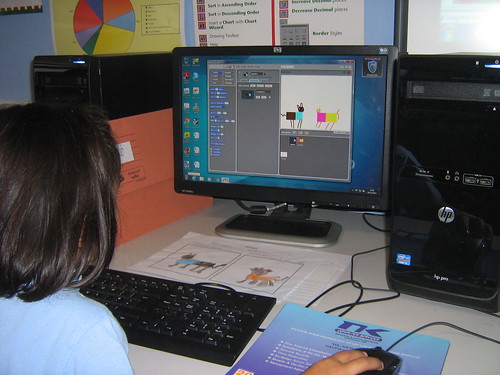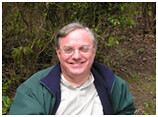How can teachers get to grips with computer programming, and where do we start? By Lawrence Williams
Many teachers have been utterly dismayed by the seemingly impossible demands of the new Programmes of Study for Computing. How can we all suddenly develop a wide range of new skills in Computing? Can our pupils, aged from only 5 years, really understand, write, and debug computer programmes? It seems an impossible task. But help is at hand…. And from a teacher of English, with no Computing training! (Though with some experience in using ICT.)
Lawrence Williams explains.
I am of a generation that remembers the wonderful cross-curricular, collaborative, and creative projects undertaken in our Primary schools, a process sadly destroyed by the introduction of the National Curriculum in the 1990s. By using Scratch as the tool, however, we have the opportunity to replace this lost teaching model, and by simultaneously introducing the new Computing curriculum.
Let’s start with a reminder of what pupils aged 5 must be able to do, but with some helpful hints added to the mix:
- Understand what algorithms are, how they are implemented as programs on digital devices, and that programs execute by following precise and unambiguous instructions?
Response: A cake recipe is an algorithm! - Create and debug simple programs?
Response: Scratch is an easy-to-use block coding computer programming language, and pupils as young as 5 and 6 have had great fun using it to make animated stories. By animating their story, using Scratch, they are creating a simple program, and by changing the story’s timings to improve the visual effects, they are debugging and developing a simple program. - Use logical reasoning to predict the behaviour of simple programs?
Response: By asking the pupil, “What do you think will happen if you …….. and why do you think this?” you are developing, and they are using logical reasoning, to predict the behaviour of the Scratch program. - Use technology purposefully to create, organise, store, manipulate and retrieve digital content?
Response: Simply make up the story, save the work, and add more to it each lesson.
Job done.
The key to success, therefore lies in developing the curriculum project: Literacy from Scratch. I know it works, because I have done it. Here is a photo (permissions granted, of course) of a KS1 pupil in action. Look carefully at the picture:
 KS1 pupil creating Sprites for her Scratch story. Credit: Lawrence Williams, with acknowledgement to Swaminaryan School.
KS1 pupil creating Sprites for her Scratch story. Credit: Lawrence Williams, with acknowledgement to Swaminaryan School.
On the left is an orange folder with her story in it. This was prepared during her English lessons, following literary stimulus lessons from her teacher. In front of her, on the desk, is a draft picture of the two characters which she hand-drew for her story, in her Art lessons.
On the screen is a digital version of her characters, made in the Paint section of Scratch.
Each pupil in Year 1 and in Year 2 then created two story characters (Sprites) and three background scenes (for the Beginning, Middle, and End structure of their stories). Simple, two colour-wash backgrounds work best.
Each pupil programmed Scratch to change from scene one, to scene two, and then to scene three.
Each pupil then added a simple animation effect for one, or more, of the characters.
On the web are several stories created in this classroom, to prove it. See: http://www.literacyfromscratch.org.uk/pupils/ks1.htm
Some pupils also added “voice-over” sound files in various languages. All of these files can be downloaded and deconstructed, so that you can see how they work.
My completely free support web site: www.literacyfromscratch.org.uk has been developed specifically to explain this whole process, together with help sheets, lesson plans, schemes of work, pupils’ work, teachers’ work, evaluations, pedagogy (the project now runs also in the Czech Republic, and in Italy) and it has a search engine to help you find what you need.
Above all, we had great fun making our stories, and animating them at KS1 and KS2 and at KS3.
In conclusion, here are some comments by one of the teachers from a school in which I worked. Donna Roberts (a Year 1 teacher) writes:
“I never thought that five year old students would be able to progress as quickly, and with as much innovation, enthusiasm, and focus as my students have. They are all so proud of their work, and we hope our experience will aid you in assisting your students along their Scratch journeys towards success in the new Computing curriculum. The best advice I can give you is to embrace the concept of programming, and allow your students to work at their own pace, while giving them enough skills and information in order for you to give support to the ones who require it, while allowing the more able children the freedom to explore their abilities through the knowledge they possess and develop. At times, quite frankly, this process has been frustrating, with multiple hands in the air, and students calling out, “Miss Roberts! I need your help!” but I have seen such a massive progression in their skills that the calls have now become, “Miss Roberts! Look at what I can do!”
Try it.
You will be amazed at how exciting the project can be, and, perhaps more importantly, how you can so easily develop creative writing, art, and Computing, all at the same time.
A website-related text book, “Introducing Computing: a guide for teachers” is also available, at: http://www.routledge.com/books/details/9781138022850/
About Lawrence Williams
 Lawrence Williams is an experienced classroom practitioner, who currently teaches Literacy, ICT, and Computing on ITE courses at a number of universities in London, and abroad. He is both a Senior MirandaNet Fellow and Ambassador, and has represented the United Kingdom on behalf of the DfES, and for Becta at international conferences. His interests are in literacy, creative uses of ICT, cross-curricular learning, and international collaborations, on which he has published widely. He has received many national and international awards, including a National Teaching Award for the “Most Creative use of ICT in Secondary Schools”, and the 2012 Naace ICT Impact Award: Life Long Achievement.
Lawrence Williams is an experienced classroom practitioner, who currently teaches Literacy, ICT, and Computing on ITE courses at a number of universities in London, and abroad. He is both a Senior MirandaNet Fellow and Ambassador, and has represented the United Kingdom on behalf of the DfES, and for Becta at international conferences. His interests are in literacy, creative uses of ICT, cross-curricular learning, and international collaborations, on which he has published widely. He has received many national and international awards, including a National Teaching Award for the “Most Creative use of ICT in Secondary Schools”, and the 2012 Naace ICT Impact Award: Life Long Achievement.
This article first appeared in Digital Education, the free newsletter for those with a professional interest in educational ICT and Computing. One of the benefits of subscribing – apart from access to unique content – is articles in a timely manner. For example, this article was published in the Early October 2014 edition.To sign up, please complete the short form on our newsletter page. We use a double opt-in system, and you won’t get spammed.